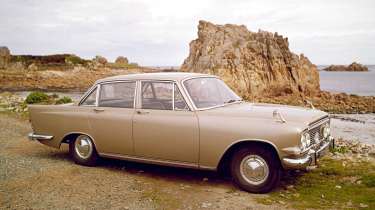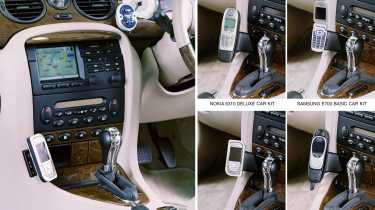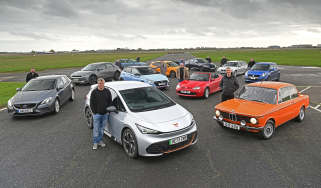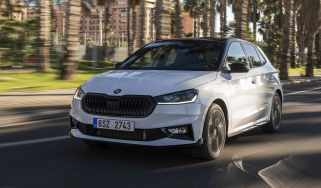Rise of the repmobile: a company car history lesson
Our love affair with company cars can be traced back to the post-war years
Could you imagine the horror of having to fork out £1.33 per mile to run a new sub-1.0-litre car? Or how about a financially crippling £2.10 per mile for a car with an engine of 2,001cc to 2,250cc? According to Automobile Association figures from 1957, adjusted to present day prices, these were the real-world costs that motorists had to face, with the most common sub-1,500cc models costing up to £1.75 a mile.
Such enormous running costs (between 6p and 11p a mile at fifties prices) meant that most people couldn’t afford to buy and run a factory-fresh car, so a new trend developed in the post-war years: companies were buying cars for their employees to run around in, usually for work but not exclusively so. Some even paid for their employees’ private mileage to encourage the vehicle’s keeper to treat it as their own, so they’d look after it that much more. Less benevolent companies insisted that their employees pay for any private mileage, in an attempt to recoup some of the high cost of buying and running a new car.
By 1964 there were about seven million cars registered in the UK and of these, around 500,000 were company vehicles. Another 700,000 were at least partly paid for by the owner’s employer, while about 800,000 or so were owned by self-employed keepers.
Despite this, the Government had yet to introduce a formal company car tax, even though subsidised ownership was a valuable perk for so many people. The average wage back then was £800 per year, but those who earned more than £2,000 usually came to some arrangement with the tax man. This involved paying around a pound a week (£17 at current prices) for a company vehicle, which was invariably used almost exclusively for private mileage.
The taxman cometh
Colin Rowden ran various company cars for an array of large companies between the mid-sixties and late-eighties. Of those early days he comments: “The arrangements were very loose when it came to paying tax. The Inland Revenue wasn’t interested in taxing sales reps who were assumed to use their cars almost exclusively for company business. Some employees were given a choice of makes and models, while others had whatever they were given. Most cars were kept for two years because they weren’t expected to work reliably after that; an Austin Cambridge or Hillman Hunter was clapped out after 60,000 miles.”
Reflecting the wider market, for the first few decades after WWII, virtually all company cars were British, the staple brands being Ford, Austin, Hillman and Morris. For those a bit further up the corporate ladder a Rover, Triumph or Wolseley was within reach, or maybe even a Jaguar or Vanden Plas. Virtually all of these were three-box saloons, with the odd estate thrown in for good measure. Few were capable of much more than 80mph; with its 39bhp 1.0-litre engine the Ford Anglia 105E topped out at 79mph, while the 48bhp Morris Minor 1000 could only reach a 72mph maximum. The Rover P4 was seen as more of an executive car and it came with a wide array of engine options, few of which provided a top speed of more than 85mph.
In 1958 the opening of the Preston bypass, the UK’s first motorway, marked the dawn of a new era, and within a year the first section of the M1 had been opened. Hundreds more miles of motorway would be created over the next decade including the M6, M4 and M50. Reps were covering greater distances than ever, and they needed cars that were more comfortable, more reliable and faster.
Nowadays, car makers produce fleet-friendly high-value models that are dripping with kit. The practice began more than 60 years ago, but with a rather different approach: prices were kept low by providing low-spec cars. Buy a Triumph Herald S and you did without the exterior brightwork while the carpets were replaced by rubber mats, plus the heater and windscreen washers were relegated to the options list. All rather different from the high-value company specials of today with navigation, a heated steering wheel and matrix LED headlights.
When Ford introduced the Cortina in 1962 it was perfect for company car drivers, from sales reps all the way up to middle management, who would be put into entry-level 1.2-litre and 1.5-litre de luxe editions respectively, the former having to forego those windscreen washers and a heater. Employees with a bit more responsibility might get a Ford Zodiac MkIII complete with reversing lamps, two-tone paint and a super-smooth 2.6-litre straight-six engine.
It was the Austin/Morris 1100 and 1300 that ruled the roost, though. Also available in Riley (Kestrel), Vanden Plas, MG and Wolseley forms, and collectively known as ADO16, these scaled-up Minis were the most popular cars in the UK for most of the 11 years that they were available. Even when the Allegro was introduced in 1973, the ADO16 proved more popular with some company car drivers, who preferred the old car to drive, as well as its better practicality.
The seventies brought greater complexity, which wasn’t always such a good thing. At the time, Graham Pearce worked at a large British Leyland dealership. He says: “We’d get Marinas delivered from the factory with tinted glass on one side and clear glass on the other, and maybe one disc brake while all the rest were drums. On one occasion we couldn’t get an Allegro to run right so we had to open up the engine, to find that it had left the factory with only three pistons fitted!”
Sub-standard components and slap-dash construction meant that the seventies was an uncertain period for many reps, who were never sure whether or not they’d get to their destination. But once the eighties dawned, things improved enormously. The Sierra replaced the Cortina in 1982, a year after the Cavalier Mk2 had superseded the Mk1. In 1984 the Austin Montego took over where the Morris Ital left off. All were big advances, with greater refinement, better packaging and – in the case of the Vauxhall and Austin – the adoption of front-wheel drive.
If a new car on the drive had been an extravagant luxury in the fifties and sixties, by the early eighties a spangly new company car was expected by many. And with company car tax now a thing, sales reps craved the greatest possible status; they weren’t going to settle for an L when they might just wangle a GL.
Colin Rowden says: “I remember on one occasion in the mid-eighties, one of my colleagues almost coming to blows with the fleet manager over his new company Sierra. He was furious that someone equal to him had been supplied with a 2.0 GL when he was given a mere 1.8 L for two years. At the crucial point, Ford couldn’t supply the 1.8 L, so a 2.0 GL came in and my colleague struck lucky. He was the envy of us all for those two years, with his extra 12bhp and slightly higher-quality interior trim!”
This competitiveness has never gone away and it’s never likely to, but there’s no such thing as a truly spartan car nowadays. By the nineties, car owners had never had it so good, but step out of a rep special from 30 years ago into something current, and the difference is stark. In the mid-nineties Rover, Vauxhall and Ford still ruled the roost, but Nissan was making inroads with the Primera, while the Honda Civic and Accord along with the Toyota Avensis were also becoming common. The really big change though, was the more widespread purchasing of German brands; Audi, Volkswagen, BMW and Mercedes were starting to lose their exclusivity, despite their notoriously sparse standard-equipment lists.
What really distorted the market, though, was taxation. Company car tax had been introduced in the seventies, and it was calculated using a vehicle’s list price and how many personal/business miles it was driven each year. That went out of the window in 2002, when it was calculated using a combination of purchase price and CO2 emissions. That put diesels, hybrids and LPG-powered cars at the forefront, although the Toyota Prius was the only mainstream hybrid available, and officially sanctioned cars that ran on LPG were few and far between. So diesels started to gain a foothold, because even though these carried a 3 per cent penalty for their particulate emissions, they were seen as planet-saving.
It would take a while, but by 2010 diesels accounted for more than half (50.6 per cent) of UK new-car registrations for the first time, but since then the figure has dropped ever further and now just one in 20 new cars is a diesel, with company car drivers moving pretty much wholesale into electric cars, once again because of changes in tax rules.
Many of them aren’t complaining though, because if they’re canny, they can run their cars for less than 1957 costs – and we don’t mean when adjusted for inflation. Run a Tesla Model 3 Long Range AWD as a company car and your tax bill will be just £375 per year if you’re a 40-per cent taxpayer. Drive 5,000 private miles annually, and that works out at 7.5p per mile, which is less than your grandpa was paying in 1957, and he didn’t have heated seats, an eight-speaker hi-fi and self-driving capabilities. No wonder company cars are still so sought after.
Changing tech
It’s amazing how the expectations of company car drivers just a couple of generations apart differ. In the fifties, an A-Z atlas, a built-in heater and some woolly seat covers were considered the height of luxury for reps, whereas the company car driver of 2024 won’t accept anything less than voice control and massaging seats. By the late sixties a push-button radio was as much as you could hope for, and it wasn’t until well into the eighties that cruise control, anti-lock brakes and electric windows might be up for grabs.
In the nineties car phones became the norm, although by 1976 there were already 250,000 radio telephones in use across the UK, despite the £750 purchase cost (£4,800 in today’s money) and call charges of 24p per minute, equivalent to £1.54 today. A new cellular network was set up in 1985 so that mobile phones could go mainstream, but prices for a plumbed-in handset still began at £1,200 (equivalent to £3,550 now). If you wanted the truly portable Motorola DynaTAC 8000X phone, you had to pay a whacking great £3,300 (£9,800 now).
By the mid-nineties a mobile phone was on every sales rep’s centre console, thanks to the introduction in 1992 of the first mass-produced handset – Nokia’s 1011 – capable of storing a mind-blowing 99 contacts. Just a few years later, integrated sat-nav would be expected, along with parking sensors, reversing cameras and adaptive cruise control, and by the early noughties a raft of safety tech was also taken for granted. It would have been enough to blow your grandad’s mind, at the wheel of his asthmatic side-valve Ford Pop.
Have you ever had a company car? Tell us your favourite in the comments section...
Find a car with the experts







